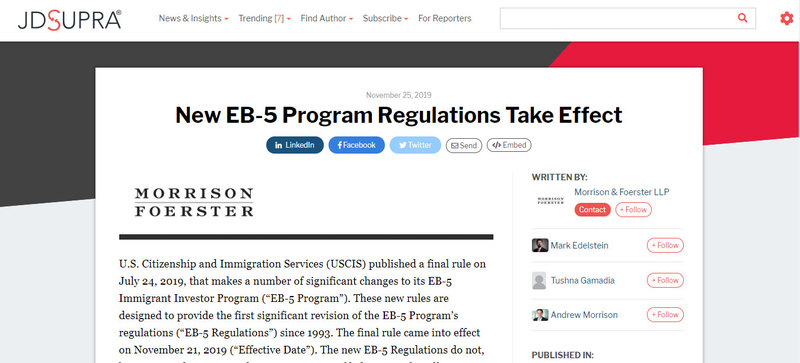New EB-5 Program Regulations Take Effect
U.S. Citizenship and Immigration Services (USCIS) published a final rule on July 24, 2019, that makes a number of significant changes to its EB-5 Immigrant Investor Program (“EB-5 Program”). These new rules are designed to provide the first significant revision of the EB-5 Program’s regulations (“EB-5 Regulations”) since 1993. The final rule came into effect on November 21, 2019 (“Effective Date”). The new EB-5 Regulations do not, however, apply retroactively to EB-5 petitions filed prior to the Effective Date.
Under the EB-5 Program, which was created by Congress in 1990, individuals (and their eligible family members) who make a qualifying investment in the United States that creates at least 10 permanent full-time jobs in the United States are eligible to apply for conditional lawful permanent residence in the United States for themselves and some family members. The purpose of the EB-5 Program is to create new jobs and boost the U.S. economy by attracting foreign investment. Since construction projects lend themselves well to the stated goal of the EB-5 Program of creating jobs in communities in need of economic development, EB-5 funds have been a popular source of relatively inexpensive capital for many prominent development projects since the last economic downturn. Several changes to the EB-5 Regulations are briefly summarized below:
- Raising minimum investment amounts: As of the Effective Date of the new EB-5 Regulations, the minimum investment level required of each investor will increase from $1 million to $1.8 million. The new EB-5 Regulations also maintain the 50% less minimum investment requirement for a Targeted Employment Area (TEA), defined as an area of high-unemployment, by increasing the minimum investment amount in a TEA from $500,000 to $900,000. The new rule also provides that the minimum investment amounts will automatically adjust for inflation every five years. According to USCIS, the reason for the significant increase in minimum investment amounts is to account for inflation since the inception of the program.
- TEA designation changes: The new EB-5 Regulations make changes related to the designation of TEAs under the EB-5 Program, where the average unemployment rate is at least 150% of the national unemployment rate. The minimum investment amounts in a TEA are half the required amount of investments in a non-TEA, therefore making projects in a TEA more competitive and attractive to investors while boosting economic development in TEAs. Under the existing EB-5 Program, TEAs are designated by the states in which the project is located and can be created by combining a series of census tracts such that neighborhoods with high unemployment and poverty rates, from which workers can travel to the investment project, even though the site of the project may be located in a more affluent neighborhood, could qualify as TEAs. Under the new EB-5 Regulations, the Department of Homeland Security (DHS), of which USCIS is a part, will eliminate a state’s ability to designate certain geographic and political subdivisions as high-unemployment areas, and, instead, DHS will make such designations directly based on revised requirements in the new EB-5 Regulations limiting the composition of census tract-based TEAs. Under the new EB-5 Regulations, DHS will add cities and towns with a population of at least 20,000 located outside of Metropolitan Statistical Areas as areas that may qualify as TEAs based on high unemployment. In addition, under the new EB-5 Regulations, a TEA may consist of a census tract or contiguous census tracts in which the new commercial enterprise (i.e., the project being constructed) is principally doing business if (a) the project is located in more than one census tract and (b) the weighted average of the unemployment rate for the tract or tracts is at least 150% of the national average. According to USCIS, the purpose of these revisions is to help ensure TEA designations are created “fairly and consistently” and avoid “gerrymandering” of census tracts to create TEA designations. There is some concern that there will be significant delays in projects and processing of investor’s permanent residence visas as a result of the backlogs at governmental agencies like DHS. States were able to certify TEAs within a few weeks, whereas it takes USCIS several years to review and approve an EB-5 petition.
- Clarifying USCIS procedures for removing conditions on permanent residence: Under the EB-5 Program, an investor’s spouse and children under the age of 21 years (referred to as derivatives) can also obtain permanent residence status if the investor’s permanent residence application is approved. Under the EB-5 Program, the investor and investor’s family members are first issued a conditional green card if USCIS finds them to be eligible, and, after a period of two years, the investor and investor’s family members can apply to USCIS to have the conditions on their green card removed and obtain full permanent resident status. The new rule will revise the EB-5 Regulations to make clear that certain derivative family members who have obtained a conditional green card must file petitions independent from the investor’s petition to remove conditions on their permanent residence. The requirement would not apply to those family members who were included in a principal investor’s petition to remove conditions. This rule change will allow family members of investors who, for whatever reason, do not apply to have the conditions on their green cards removed to independently apply to have conditions on their green cards removed. USCIS’s stated goal, with respect to this change, is to improve the adjudication process for removing conditions by providing flexibility in interview locations (since family members can now schedule interviews at a USCIS office near them).
- Allowing EB-5 petitioners to keep their priority date: The new EB-5 Regulations also allow immigrant investors who have a previously approved EB-5 immigrant petition and need to file a new EB-5 petition (for example, due to some change in the project that they invested in) to generally retain the priority date of their previously approved petition, subject to certain exceptions. This means that such investor will not be required to lose their place in line for the date on which USCIS will adjudicate such investor’s petition. This change is important to investors due to the long wait times involved in obtaining permanent residence status, since USCIS only issues a total of 10,000 visas (subject to changes effective November 21, 2019) under the EB-5 Program each year and the EB-5 Program is oversubscribed and has long processing times that grow longer each year (especially for Chinese investors, whose current estimated wait times are approximately 16.5 years).
USCIS has stated that the goal in revising the EB-5 Regulations is to “strengthen the EB-5 program by returning it to its Congressional intent.” In reality, there is a likelihood that the new EB-5 Regulations could effectively make sourcing EB-5 investments and creating new jobs in the United States more challenging while providing access to the EB-5 Program to only the wealthiest of foreign investors by significantly raising the minimum investment levels and restricting TEA designations. The new EB-5 Regulations do not specifically contain any “integrity measures” aimed at preventing fraud, such as requiring more regulation of regional centers or more transparent reporting of projects by regional centers, which has been a concern for investors and the United States government due to the actions of a handful of regional centers and developers. The final impact of the new EB-5 Regulations remains to be seen, and we will continue to monitor developments in the EB-5 Program.
For your reference, we have created a chart that summarizes the changes to the EB-5 Regulations effective as of November 21, 2019.
https://www.jdsupra.com/legalnews/new-eb-5-program-regulations-take-effect-87510/
Mentions
States
- New York
Videos





Subscribe for News
Site Digest
Join Professionals on EB5Projects.com →
Securities Disclaimer
This website is for informational purposes only and does not constitute an offer or solicitation to sell shares or securities. Any such offer or solicitation will be made only by means of an investment's confidential Offering Memorandum and in accordance with the terms of all applicable securities and other laws. This website does not constitute or form part of, and should not be construed as, any offer for sale or subscription of, or any invitation to offer to buy or subscribe for, any securities, nor should it or any part of it form the basis of, or be relied on in any connection with, any contract or commitment whatsoever. EB5Projects.com LLC and its affiliates expressly disclaim any and all responsibility for any direct or consequential loss or damage of any kind whatsoever arising directly or indirectly from: (i) reliance on any information contained in the website, (ii) any error, omission or inaccuracy in any such information or (iii) any action resulting therefrom.



